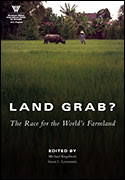-
VIDEO—Pape Gaye: Improving Maternal Health Training and Services
›February 12, 2010 // By Julia Griffin“Training is probably one of the biggest interventions in terms of making human resources available,” says Pape Gaye, President and CEO of IntraHealth International, to ECSP’s Gib Clarke in this interview on improving maternal health services in developing countries. “Unfortunately, there are a lot of problems associated with training.”
Gaye says obstacles to scaling up maternal health services in rural areas include employee gender inequalities, poor coordination of supplemental training, and a tendency to only offer in-service training in urban areas. Properly emphasizing pre-service education, he underscores, could remedy some of the problems associated with service provider training.
Increasing retention of medical practitioners is also critical to improving maternal health services in developing countries, Gaye explains. In his experience, however, attempts to address perceived security and financial compensation inadequacies produced mixed results. Instead, Gaye suggests that positive recognition may be one of the best methods for retaining health care workers. “We’re seeing some very good successes in places where we have just simple ways to recognize the work… because if people feel valued in a community, then they are likely to stick it out.” -
Point of View: Investing in Maternal Health
› Every minute, a woman dies in pregnancy or childbirth. But the overwhelming majority of these more than 500,000 deaths a year are avoidable.
Every minute, a woman dies in pregnancy or childbirth. But the overwhelming majority of these more than 500,000 deaths a year are avoidable.
“We know how to save women’s lives, we don’t need a cure…this is a political problem and political will is essential,” said Theresa Shaver, the director of White Ribbon Alliance.
Addressing longstanding issues like political will could jumpstart progress toward Millennium Development Goal 5, which seeks to reduce maternal deaths by 75 percent by 2015. We face daunting challenges, but there are some clear steps we can take to meet this critical goal. We must strengthen health systems in the developing world.Increasing women’s access to quality health services during pregnancy, and ensuring they are attended by skilled providers during childbirth, can help to reduce preventable causes of death, such as hemorrhage, pre-eclampsia, and obstructed labor—which together account for 80 percent of maternal deaths.
Scaling-up family planning services are a cost-effective way of preventing unwanted pregnancies, delaying the age of first pregnancy, increasing the time between pregnancies, and facilitating important relationships between women and health care providers. However, many societal and cultural factors dissuade women and girls from seeking contraception. Culturally sensitive education programs can help overcome this barrier, especially if they include men and local leaders, in addition to women and girls.
We should recognize that improving the well-being of mothers is inseparable from the health of newborns. Efforts to reach Millennium Development Goal 4, reducing under-5 mortality by two-thirds, are integral to improving maternal health. Skilled birth attendants could decrease both maternal and child mortality.
In the United States and abroad, momentum is growing to make the investment necessary to scale up these interventions. In January, Secretary of State Hillary Clinton renewed a commitment of $63 billion for the Obama Administration’s Global Health Initiative, which will include significant resources for maternal and child health.
According to the U.S. Agency for International Development, maternal and newborn deaths cost the world $15 billion a year in lost productivity. Researchers conclude that maternal health services would cost only a $1 per day per woman. That’s a small price to pay for such a high return—saving not only dollars, but also women’s lives.
For more information about maternal health and the Global Health Initiative’s Advancing Policy Dialogue on Maternal Health Series please see this month’s issue of Centerpoint. -
Video—Integrating Population, Health, and Environment (PHE) to Conserve Ethiopian Wetlands
›February 1, 2010 // By Julia GriffinIn our latest video interview about PHE programs in Ethiopia, Zuna–a village elder from the Mettu Woreda region of Ethiopia—describes how an integrated intervention by the Ethio-Wetlands and Natural Resources Association (EWNRA) has benefited her community.
EWNRA aims to raise awareness within Ethiopian communities and governmental organizations of the importance of sustainable wetlands management. The organization also imparts local-level training on resource conservation and wise-use labor techniques.
Zuna recounts how EWNRA provided welcome training in sanitation and housekeeping practices that increased both safety and sustainability within her community. The more efficient, cleaner-burning wood stoves introduced in Mettu Woreda, for example, have improved local air quality while decreasing the frequency of skin burns and amount of harvested fuel required for cooking and other activities.
“We are benefiting from all this and I think the benefits from this intervention are good,” she says through an interpreter. “I want them to keep doing this and hopefully we will improve our activities working with them.” -
Gates: More Money for Global Health Is Good for the Environment
›January 28, 2010 // By Gib Clarke Bill Gates gave the PHE community a much-needed upgrade in his foundation’s 2nd Annual Letter, released this week. Unfortunately it still has a few bugs.
Bill Gates gave the PHE community a much-needed upgrade in his foundation’s 2nd Annual Letter, released this week. Unfortunately it still has a few bugs.
“In the long run, not spending on health is a bad deal for the environment because improvements in health, including voluntary family planning, lead people to have smaller families, which in turn reduces the strain on the environment,” concludes Gates.
This statement could dramatically raise awareness of and funding for population-environment programs. Any time Bill Gates talks, the world listens, as evidenced by the barrage of coverage from Reuters, AFP, and top IT newswires. For the public, it offers a rare glimpse into development strategy, so Gates’ thoughts (and financial commitments) could be seen as representative of the foundation community’s approach to global health problems.
Although it may seem obvious that fewer people place less strain on the environment, this connection has been largely absent from the environmental agenda, including the efforts to combat climate change. Some environmental leaders and organizations have dismissed population as an unimportant distraction from the real business at hand. Others have noted that population growth’s impact on climate change is far greater in the rich world than in poor countries, whose per capita emissions are a fraction of developed countries’.
Gates’ comment may cause those in the first camp to re-evaluate the importance of family planning, and it is likely to energize the converted. But it will have less impact on those focused on consumption. But if it encourages the environmental community to put population and family planning issues back on the table, it will have gone a long way.
However, Gates could have gone further, by explaining that family planning is a relatively inexpensive way to mitigate climate change, compared to complex and emerging technological solutions. He also could have pointed out that climate change is expected to increase the prevalence of vector-borne diseases such as malaria, or that sick or malnourished individuals may be forced to mismanage natural resources.
Because Gates didn’t make these explicit connections, many in the media missed his point. The wire headlines pit health against environment, when Gates was in fact pointing out how interdependent they are. This distortion is symptomatic of the media’s tendency to highlight the horserace. But maybe they would pay closer attention if the Gates Foundation put its money where its mouth is—and funded programs that integrate family planning and the environment.
Perhaps several years from now, we will look back and say that this letter marks the start of the Gates Foundation’s integrated approach to development. But we may need to wait for Letter 3.0 for a complete install.
Photo: Courtesy Flickr User World Economic Forum -
Oli Brown on Climate Security and Environmental Peacebuilding
›January 28, 2010 // By Sajid Anwar“Climate change seems to be eclipsing all other environment and security issues, but those issues haven’t gone away,” says Oli Brown, program manager at the International Institute for Sustainable Development (IISD). “There are still problems with illegal timber, still problems with mining, there are still problems with diamonds, there are still problems over land, water, and so on. Climate change encompasses a lot of those issues and makes some of them more difficult and more pressing.”
IISD is working with the United Nations Environment Programme on ensuring that these issues are addressed in UN peacekeeping missions. “What we do with UNEP is to coordinate a group of experts that help to advise the UN family on ways that it should do conflict prevention, post conflict reconstruction, peacekeeping, peace negotiations and peacebuilding more effectively,” says Brown. -
Land Grab: Sacrificing the Environment for Food Security
›January 27, 2010 // By Wilson Center Staff According to the United Nations, 74 million acres of farmland in the developing world were acquired by foreign governments and investors over the first half of 2009 – an amount equal to half of Europe’s farmland.
According to the United Nations, 74 million acres of farmland in the developing world were acquired by foreign governments and investors over the first half of 2009 – an amount equal to half of Europe’s farmland. -
Peace Through Parks on Israel’s Borders – Dream or Reality?
›In areas fraught with conflict, is it possible to advance conflict resolution through environmental discourse? A recent conference hosted by Tel Aviv University’s Porter School of Environmental Studies explored this question through an examination of existing peace parks, as well as possible future preserves.
The wide-ranging discussion sought to apply theories of conflict resolution and environmental peacemaking to local conflict in the Middle East. Touching on conservation, conflict resolution, local history, geography, ecology, and diplomacy, the participants underscored the importance of restoration efforts, local environmental maintenance, and the pursuit of peace through environmental cooperation.
For more, watch these presentations on YouTube (in English; with Timestamps):
Event Part One:
0:15:50
“Conservation to Conflict Resolution: Understanding the Theory and Practice of Peace Parks”
Dr. Saleem Ali, Rubenstein School of Environment and Natural Resources, University of Vermont
1:36:28
“Peace Parks on Israel’s Borders: Lessons from South Sinai”
Dr. Dan Rabinowitz, Department of Sociology and Anthropology, Tel Aviv University
1:55:49
“The Jordan River Peace Park: Post-conflict environmental peacebuilding between Israel and Jordan”
Gidon Bromberg, Israeli Director, Friends of the Earth Middle East
Event Part Two:
0:01:12
“The Golan Heights – A critical habitat with global significance”
Dr. Tamar Ron, Ecologist, biodiversity conservation consultant
2:11:01
Session Response:
Valerie Brachya, Director, Environmental Policy Center Jerusalem Institute for Israel Studies
Photo: Golan Heights Panorama, Courtesy Flickr User Vad_Levin. -
Watch: Harriet Birungi: Challenges Facing HIV-Positive Adolescents in Kenya
›“Services are not necessarily very adolescent-friendly, so when you get children who are HIV-positive they are likely to face discrimination,” says Harriet Birungi, an associate in the Reproductive Health Program with the Population Council in Kenya, in this interview with ECSP’s Gib Clarke following the Global Health Initiative’s Integrating HIV/AIDS and Maternal Health Services panel.
According to Birungi, medical service censoring and targeted exclusion from schools are among the top challenges facing Kenyan adolescents living with HIV/AIDS. She hopes better support systems and intervention strategies, especially for pregnant individuals, will help medical personnel more quickly identify HIV-positive young adults needing critical medical services.
 A Publication of the Stimson Center.
A Publication of the Stimson Center.

 Every minute, a woman dies in pregnancy or childbirth. But the overwhelming majority of these more than
Every minute, a woman dies in pregnancy or childbirth. But the overwhelming majority of these more than  Bill Gates gave the
Bill Gates gave the  According to the United Nations, 74 million acres of farmland in the developing world were acquired by foreign governments and investors over the first half of 2009 – an amount equal to half of Europe’s farmland.
According to the United Nations, 74 million acres of farmland in the developing world were acquired by foreign governments and investors over the first half of 2009 – an amount equal to half of Europe’s farmland.

